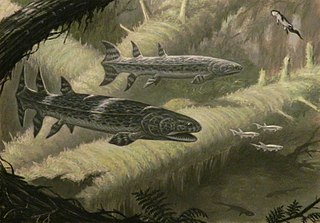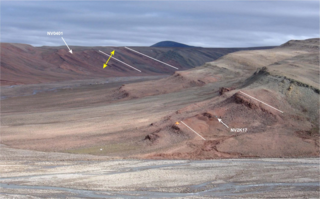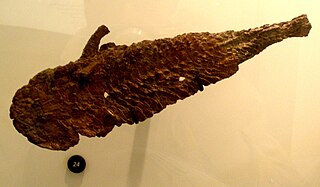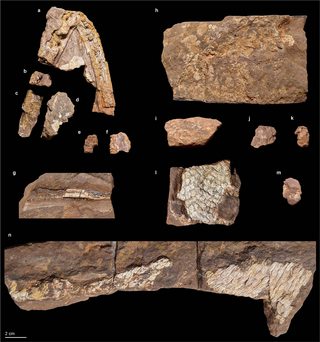
Eusthenopteron is a genus of prehistoric sarcopterygian fish known from several species that lived during the Late Devonian period, about 385 million years ago. It has attained an iconic status from its close relationship to tetrapods. Early depictions of animals of this genus show them emerging onto land, but paleontologists now think that eusthenopteron species were strictly aquatic animals, though this is not completely known.

Hyneria is a genus of large prehistoric predatory lobe-finned fish which lived in fresh water during the Famennian stage of the Devonian period.

Tiktaalik is a monospecific genus of extinct sarcopterygian from the Late Devonian Period, about 375 Mya, having many features akin to those of tetrapods. Tiktaalik is estimated to have had a total length of 1.25–2.75 metres (4.1–9.0 ft) based on various specimens.

Tetrapodomorpha is a clade of vertebrates consisting of tetrapods and their closest sarcopterygian relatives that are more closely related to living tetrapods than to living lungfish. Advanced forms transitional between fish and the early labyrinthodonts, such as Tiktaalik, have been referred to as "fishapods" by their discoverers, being half-fish, half-tetrapods, in appearance and limb morphology. The Tetrapodomorpha contains the crown group tetrapods and several groups of early stem tetrapods, which includes several groups of related lobe-finned fishes, collectively known as the osteolepiforms. The Tetrapodomorpha minus the crown group Tetrapoda are the stem Tetrapoda, a paraphyletic unit encompassing the fish to tetrapod transition.

Holoptychius is an extinct genus of porolepiform lobe-finned fish from the Middle Devonian to Carboniferous (Mississippian) periods. It is known from fossils worldwide. The genus was first described by Louis Agassiz in 1839.
Kenichthys is a genus of sarcopterygian fish from the Devonian period, and a member of the clade Tetrapodomorpha. The only known species of the genus is Kenichthys campbelli, the first remains of which were found in China in 1993. The genus is important to the study of the evolution of tetrapods due to the unique nature of its nostrils, which provide vital evidence regarding the evolutionary transition of fish-like nostrils to the tetrapod choanae.

The Fram Formation is an Upper Devonian (Frasnian) sequence of rock strata on Ellesmere Island that came into prominence in 2006 with the discovery in its rocks of examples of the transitional fossil, Tiktaalik, a sarcopterygian or lobe-finned fish showing many tetrapod characteristics. Fossils of Laccognathus embryi, a porolepiform lobe-finned fish, and Qikiqtania, a close relative of Tiktaalik, were also found in the formation. The Fram Formation is a Middle to Upper Devonian clastic wedge forming an extensive continental facies consisting of sediments derived from deposits laid down in braided stream systems that formed some 375 million years ago, at a time when the North American craton ("Laurentia") was straddling the equator.

Rhizodus is an extinct genus of basal, finned tetrapodomorphs. It belonged to Rhizodontida, one of the earliest-diverging tetrapodomorph clades. Two valid species have been described, both of which lived during the Early Carboniferous epoch. The type species R. hibberti is known from the Viséan stage of the United Kingdom, whereas the species R. serpukhovensis is from the Serpukhovian of Russia. Some fossils referred to the genus Rhizodus have also been found in North America.

Eusthenodon is an extinct genus of tristichopterid tetrapodomorphs from the Late Devonian period, ranging between 383 and 359 million years ago. They are well known for being a cosmopolitan genus with remains being recovered from East Greenland, Australia, Central Russia, South Africa, Pennsylvania, and Belgium. Compared to the other closely related genera of the Tristichopteridae clade, Eusthenodon was one of the largest lobe-finned fishes and among the most derived tristichopterids alongside its close relatives Cabonnichthys and Mandageria.

Tristichopterus, with a maximum length of sixty centimetres, is the smallest genus in the family of prehistoric lobe-finned fish, Tristichopteridae that was believed to have originated in the north and dispersed throughout the course of the Upper Devonian into Gondwana. Tristichopterus currently has only one named species, first described by Egerton in 1861. The Tristichopterus node is thought to have originated during the Givetian part of the Devonian. Tristichopterus was thought by Egerton to be unique for its time period as a fish with ossified vertebral centers, breaking the persistent notochord rule of most Devonian fish but this was later reinspected and shown to be only partial ossification by Dr. R. H. Traquair. Tristichopterus alatus closely resembles Eusthenopteron and this sparked some debate after its discovery as to whether it was a separate taxon.

Porolepiformes is an order of prehistoric lobe-finned fish which lived during the Devonian period. They are thought to represent the sister group to lungfish. The group contains two families: Holoptychiidae and Porolepididae.

Megalichthyidae is an extinct family of tetrapodomorphs which lived from the Middle–Late Devonian to the Early Permian. They are known primarily from freshwater deposits, mostly in the Northern Hemisphere, but one genus (Cladarosymblema) is known from Australia, and the possible megalichthyid Mahalalepis is from Antarctica.

Glyptolepis is an extinct genus of porolepiform lobe-finned fish which lived during Devonian Period, from the early Eifelian to Frasnian Age. Species include Glyptolepis baltica, Glyptolepis groenlandica, and Glyptolepis leptopterus.

Laccognathus is an extinct genus of amphibious lobe-finned fish from Europe and North America. They existed from the Middle Devonian to the Late Devonian. The name comes from Greek for 'pitted jaw'.
Heimenia is an extinct genus of prehistoric sarcopterygian or lobe-finned fish.

Laccognathus panderi is an extinct lobe-finned fish from northern Europe. They existed from the Middle Devonian to the Late Devonian.
Laccognathus grossi is an extinct lobe-finned fish from eastern Europe. They existed during the Middle Devonian. The species is named after Walter Gross, who collected the first Laccognathus fossils belonging to L. panderi.

Qikiqtania is an extinct genus of elpistostegalian tetrapodomorph from the Late Devonian Fram Formation of Nunavut, Canada. The genus contains a single species, Q. wakei, known from a partial skeleton. Analysis of the fin bones suggests that Qikiqtania was well-suited to swimming, and likely incapable of walking or supporting itself out of the water, as has been suggested for the closely related Tiktaalik.
The Zachelmie trackways are a series of Middle Devonian-age trace fossils in Poland, purportedly the oldest evidence of terrestrial vertebrates (tetrapods) in the fossil record. These trackways were discovered in the Wojciechowice Formation, an Eifelian-age carbonate unit exposed in the Zachełmie Quarry of the Świętokrzyskie Mountains. The discovery of these tracks has complicated the study of tetrapod evolution. Morphological studies suggest that four-limbed vertebrates are descended from a specialized type of tetrapodomorph fish, the epistostegalians. This hypothesis was supported further by the discovery and 2006 description of Tiktaalik, a well-preserved epistostegalian from the Frasnian of Nunavut. Crucial to this idea is the assumption that tetrapods originated in the Late Devonian, after elpistostegalians appear in the fossil record near the start of the Frasnian. The Zachelmie trackways, however, appear to demonstrate that tetrapods were present prior to the Late Devonian. The implications of this find has led to several different perspectives on the sequence of events involved in tetrapod evolution.

The Mandagery Sandstone is a Late Devonian geological formation in New South Wales, Australia. It is one of several famed Australian lagerstätten, with thousands of exceptional fish fossils found at a site near the town of Canowindra.

















